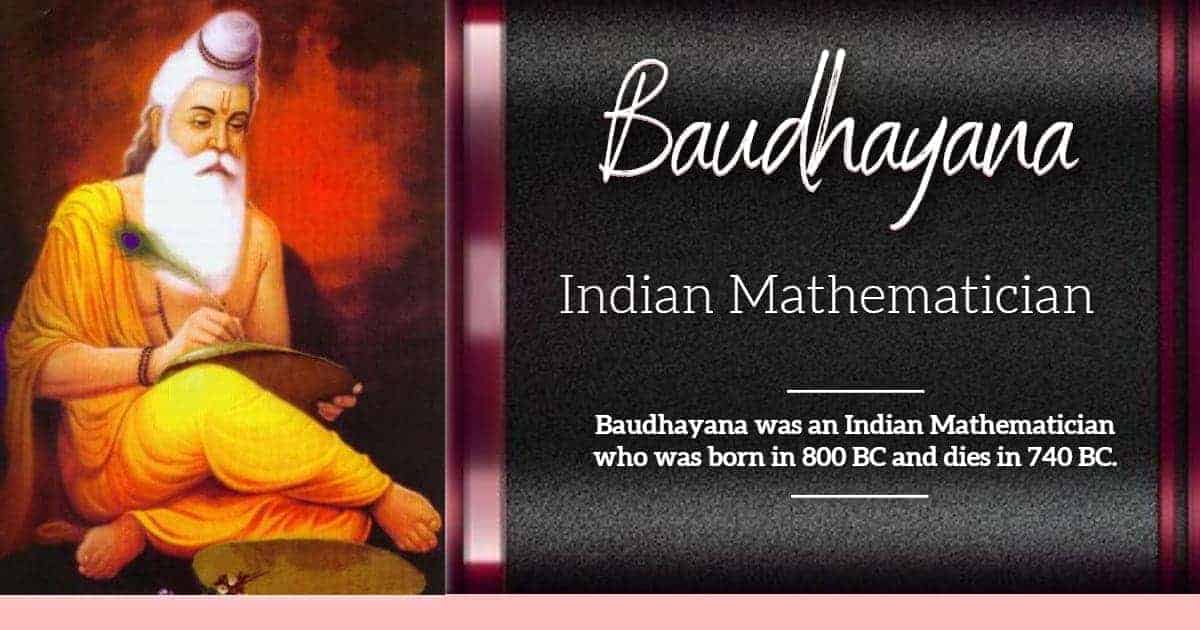Baudhayana was an Indian Mathematician who was born in 800 BC and dies in 740 BC. He was a Vedic brahmin priest. He is said to be the original founder of Pythagoras’s Theorem. He was the first-ever Indian Mathematician who came up with several concepts in Mathematics.
He was one of the mathematicians who used his mathematical skills in a practical way by being a skilled craftsman. The value of pi was first calculated by him.
Baudhayana has mentioned Pi even before the actually named as by and Pythagoras theorem was first used. Baudhāyana discovered Pythagoras at least 1000 years before Pythagoras was born. A shloka from the Śulbasûtra is proof that he had the concept of Pythagoras theorem in his mind even before the Pythagoras was actually made:
“dīrghasyākṣaṇayā rajjuH pārśvamānī, tiryaDaM mānī, cha yatpṛthagbhUte kurutastadubhayāṅkaroti.”

It means “A rope stretched along the length of the diagonal produces an area which the vertical and horizontal sides make together.”
also says that if x and y are two sides and z is the hypotenuse, such that ‘x’ is divisible by 4.
Then, z = (x – x/8) + y/2. (In all Pythagorean triplets, one of the two shorter sides should be at least be divisible by 4)
When constructing circular shapes, Bodhayana uses different approximations for π. Constructions are given which are equivalent to taking π equal to 676/225 (where 676/225 = 3.004), to 1156/361 (where 1156/361 = 3.202), 900/289 (where 900/289 = 3.114).
Bodhayana even tried to find a circle whose area is the same as that of a square.
“Draw half its diagonal about the centre towards the East-West line; then describe a circle together with a third part of that which lies outside the square”.
Bodhayana even figured out:
- Diagonals of a rhombus bisect at right angles,
- Diagonals of a rectangle bisect each other,
- The midpoints of a rectangle joined forms a rhombus whose area is half the rectangle, etc.
- The area of a square formed by joining the middle points of a square is half of the original.
He was just like the other Mathematicians who were born around 800 BC like Aryabhatta, Bhaskara, Varahamihira, Mahavira, Brahmagupta.
Table of Contents
Baudhayana Books
He is the author of Sulbasutras. Śulbasûtra is one of the oldest books on advanced Mathematics. Sulbasutras is all about rules for religious rites. This book contains several important mathematical results. This book contains 3 chapters.
In all these 3 chapters, he has written how he has calculated the value of pi, calculated the square root of 2, and circled the area of the square and worked on Pythagoras theorem.

This book has geometric solutions of a linear equation in a single unknown. Quadratic equations of the forms ax^{2} = cax2=c and ax^{2} + bx = cax2+bx=c. Approximate value for √2 is given in Chapter 1 verse 61 of this book. According to him, value for √2 is 1 + 1/3 + 1/(3×4) – 1/(3×4×34)= 577/408 which is 1.414215686 which is correct up to five decimal places.
Baudhayana has written several Sutras. These sūtras were written in Sanskrit. These sutras cover topics based on dharma, mathematics, daily ritual, etc.
The Baudhayana sutras consist of six texts:
- the Śulbasûtra in 3 Adhyāyas.
- the Dvaidhasûtra in 4 Praśnas,
- the Dharmasûtra in 4 Praśnas
- the Śrautasûtra, probably in 19 Praśnas
- the Grihyasutra in 4 Praśnas,
- the Karmāntasûtra in 20 Adhyāyas
The Baudhāyana Śulbasûtra contains several early mathematical results, like the square root of 2 and the Pythagorean theorem.
Contributions of Baudhayana in Mathematics
- He has done research on Circle, Square, Rectangle, Triangle.
- Discovered π to some degree of precision.
- He is the earliest founder of Pythagoras’s Theorem.
- He judged the square root of 2 to five decimal places of accuracy.
Interesting facts about Baudhayana
- He was a priest and a brahmin. He used to perform Yogas with other Sages.
- He had mentioned about the Pythagoras theorem 1000 years even before the name was actually coined.
- His book, Sulbasutras is one of the oldest mathematical books.
To know more about this great Indian Mathematician, read the article written by Cornell University.






,❤️❤️